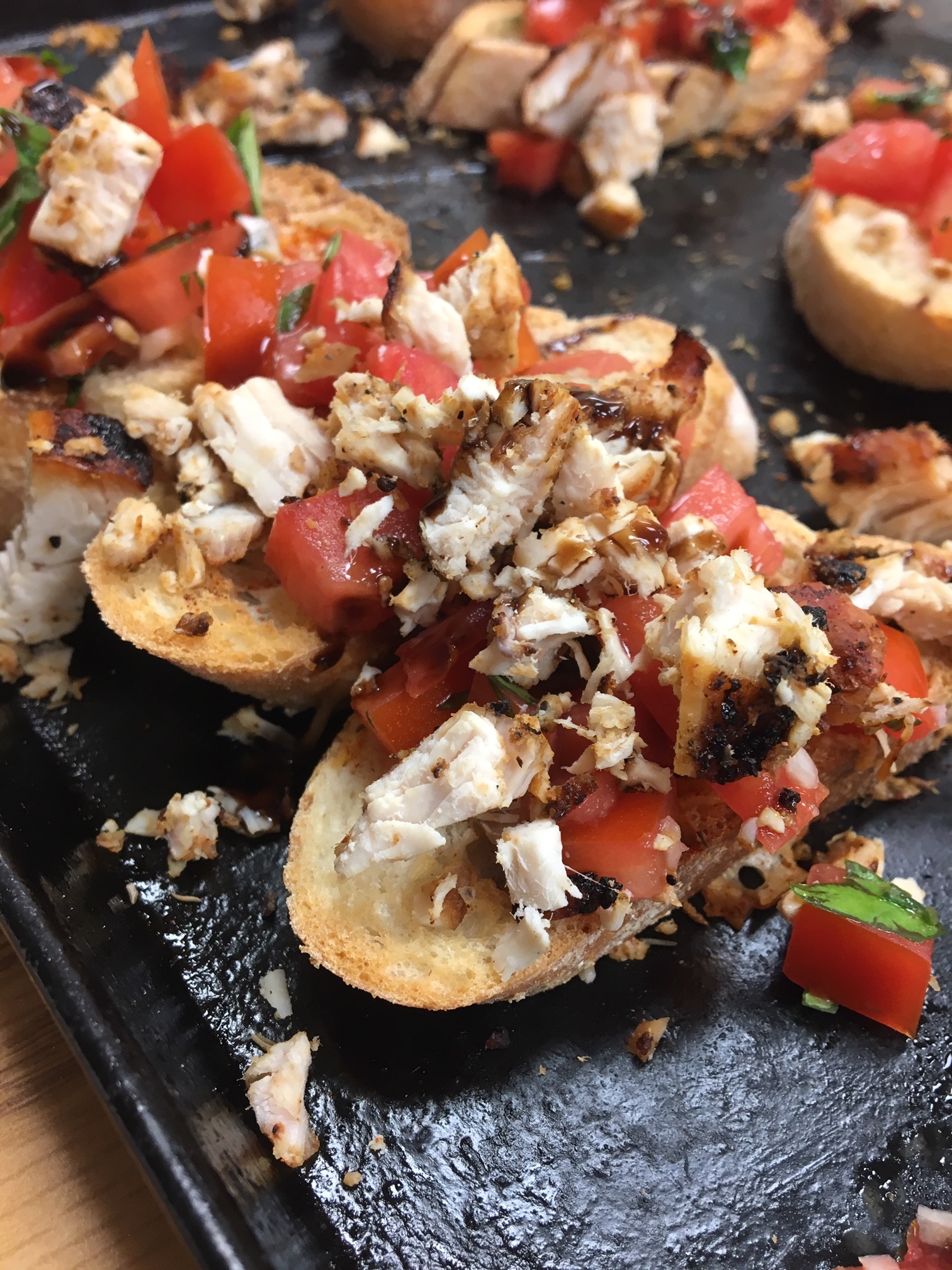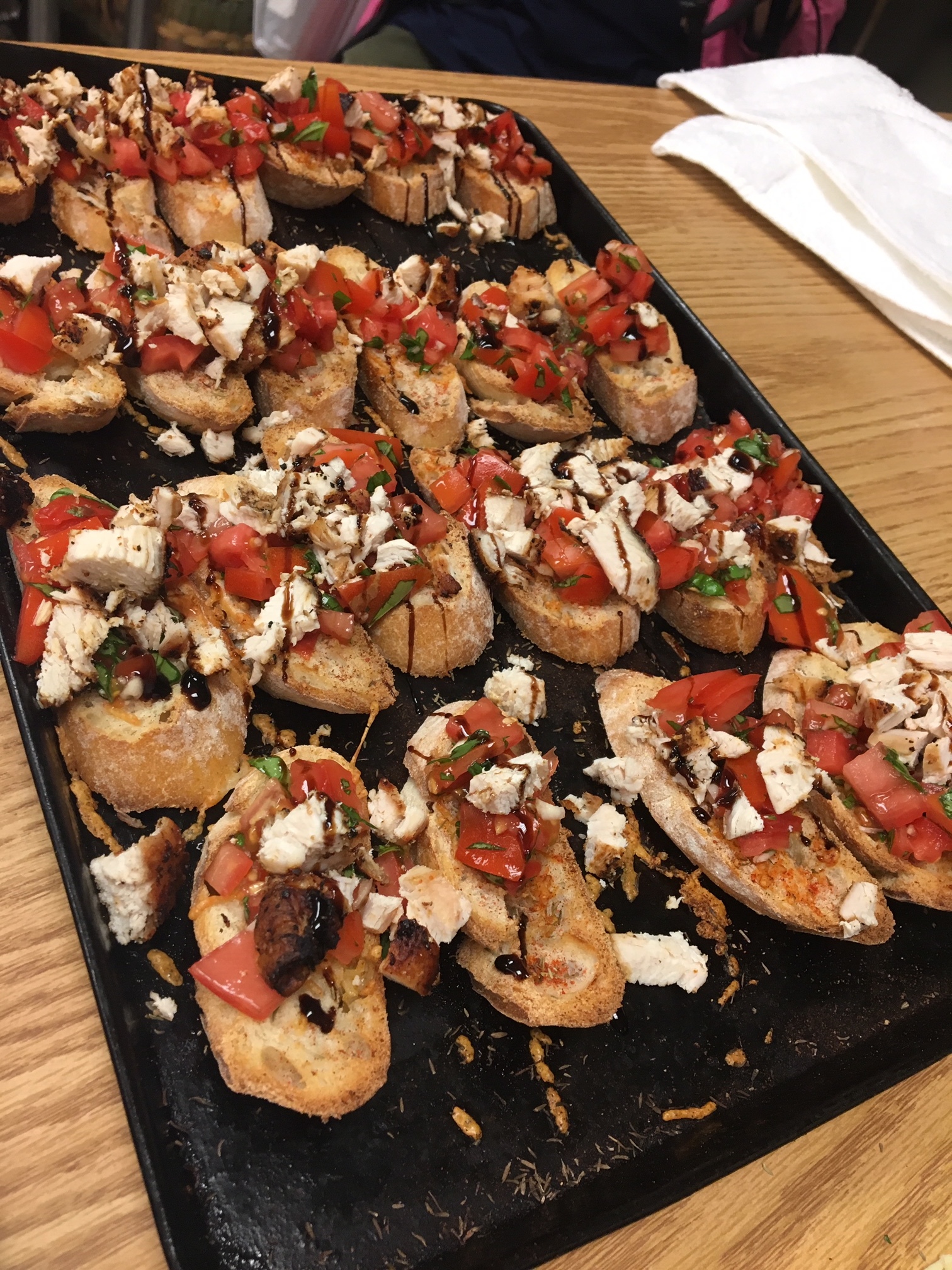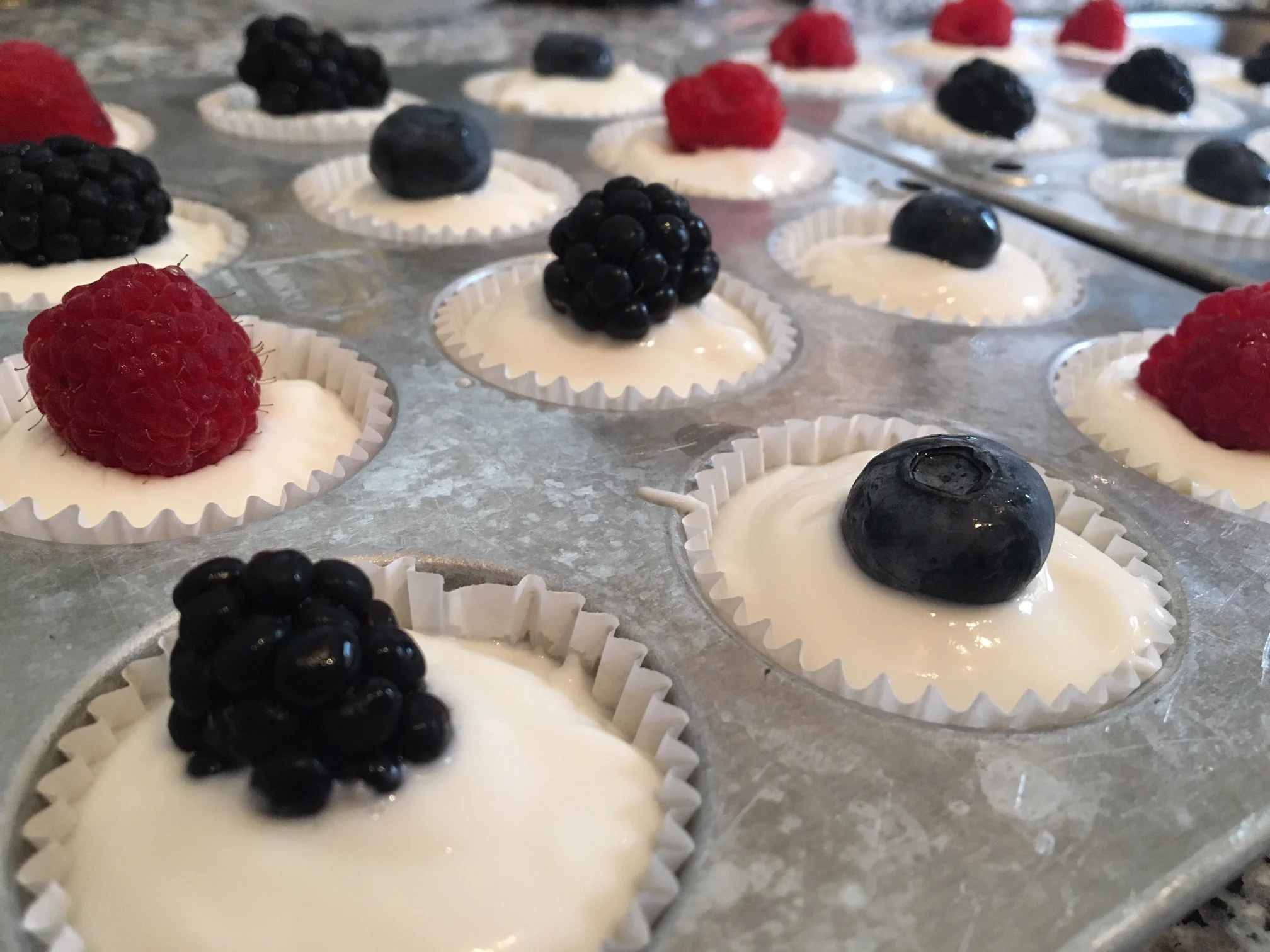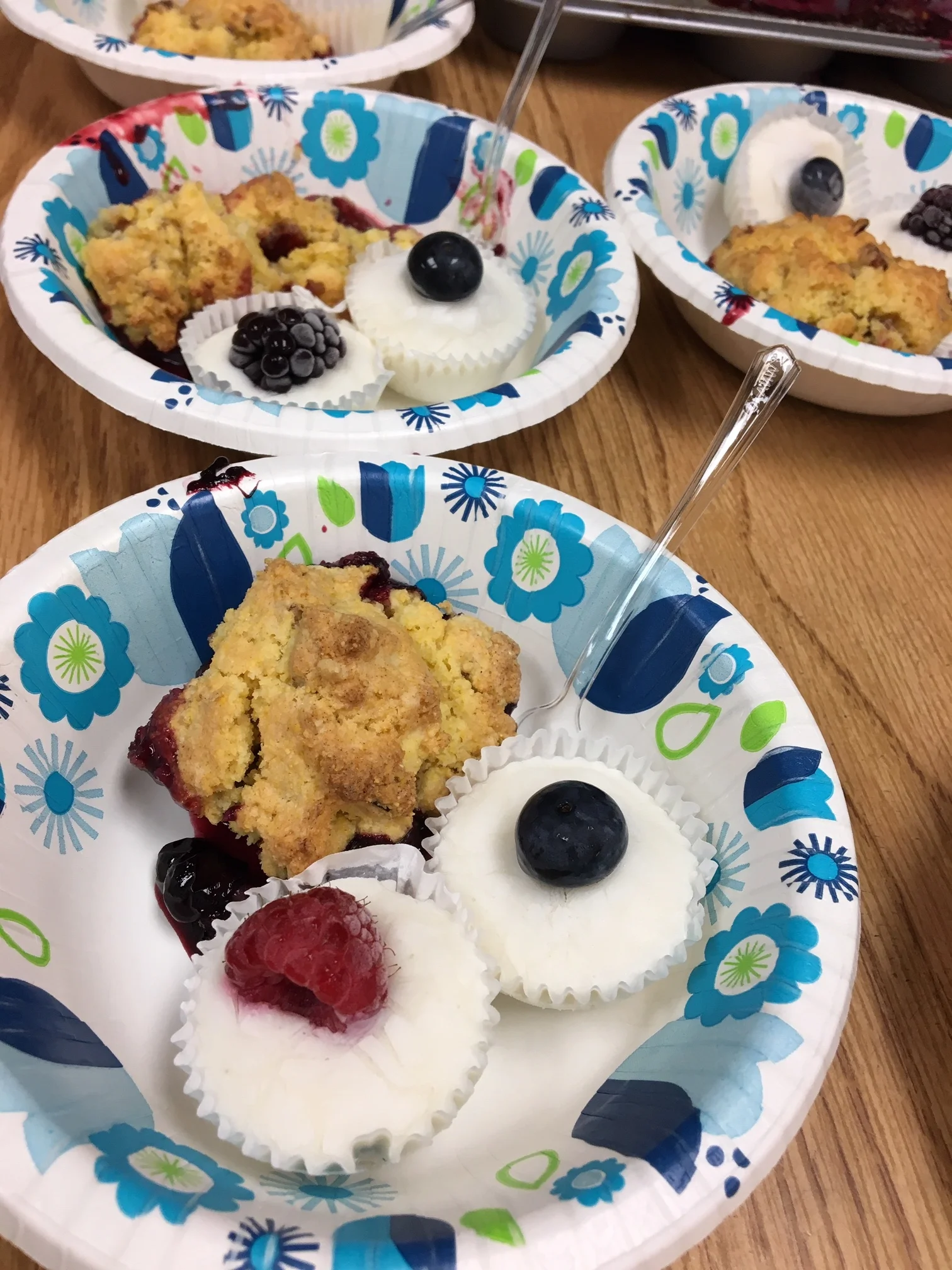Recipe Round Up 5: Progressive Food Demonstration in Old Brooklyn
This summer I was humbled to be asked to provide a series of food demonstrations for the 2019 Old Brooklyn Farmer’s Market season. Along with activities including Zumba, yoga, biking, kids’ crafts, live music, and of course tons of produce and local foods for sale, the market hosted a free cooking demonstration for the public each Saturday in a full-service kitchen.
Rather than do nutrition education and the food demos on my own, I got to team up with Chef Andrew Kisner for double the fun! Andrew is a graduate of the EDWINS Leadership & Restaurant Institute and has worked in several prestigious restaurants since graduation.
With five dates on the calendar to provide food demos, we decided to do what we called a Progressive Food Demo, drawing on the style of a progressive dinner party. Rather than having one course at each neighbor’s house, we demonstrated a different meal course at each demo throughout the summer. Our goal was to use fresh produce from the market that was in-season and would be available for participants to buy that day to make the recipe at home! We ran into some hurdles with the late growing season, so we couldn’t always source the day’s ingredients fresh from the market, but we always used fruits and veggies that were in-season at the time.
The entire meal would be quite filling and have a variety of flavors, but it would sure be delicious! Check out the nutrition for the entire meal below, and then read on for each course’s recipe, suggested portion sizes and nutrition tidbits!
SALAD COURSE:
Simple Summer Salad with Apple Butter Basil Vinaigrette
We wanted to purchase fresh salad greens at the market for this salad course, but there weren’t enough vendors with greens to go around, so we settled on using fresh, local basil, scallions, tomatoes and apple butter from a couple of the farm stands just steps outside the kitchen. This salad could be bulked up with any extra chopped veggies or fruits, roasted nuts or seeds and is also great for fall weather. The apple butter basil vinaigrette will have you daydreaming about hayrides and crunching leaves before you know it!
Click the photo below for the recipe.
Nutrition at a Glance:
Notable Nutrition:
Vitamin A is a powerful antioxidant for the body, essential for cell repair, strengthening the immune system and keeping our eyes in tip-top shape. Signs of deficiency include dry eyes, night blindness, and hair loss. The active form of Vitamin A comes from animal food sources such as oily fish, cheese and eggs. Provitamin A includes carotenoids, which get converted to active forms in our body once digested. Plant sources include dark leafy greens; dark red and orange veggies such as tomatoes, sweet potatoes and carrots; and red/orange fruits such as mango, watermelon and cantaloupe.
Apple cider vinegar gets a lot of buzz on the internet, claiming to help with weight loss, blood sugar control and other quick health fixes. However, there is not scientific evidence that these claims are true, and regular, solo consumption of ACV can actually cause more harm than good. Its high acidity can cause enamel decay on teeth and damage the esophagus or stomach lining, and research is showing that it may also lower potassium levels, which can lead to poor health outcomes and muscle function. Quick fix claims like drinking apple cider vinegar will never be able to outperform the overwhelming scientific evidence supporting general healthy lifestyles with a balanced eating pattern, lots of physical activity and quality sleep.
APPETIZER:
Mixed Herb Bruschetta with Balsamic Chicken
This is a quick and flavorful appetizer to make for a party or viewing a weekend game! Like the salad, the tomatoes and herbs were sourced from the local farmers just outside the kitchen at the market tables. For an even faster preparation, use a ready-made balsamic glaze instead of reducing balsamic vinegar yourself, which can take up to 30 minutes.
Click the photos below for the recipe.
Nutrition at a Glance:
Notable Nutrition:
This appetizer’s main vehicle is a French baguette, which means GLUTEN! Gluten is a complex of proteins, glutenins and gliadins, found within wheat, rye, barley and some other grains that function to give bread its elasticity and rising properties. Gluten makes up the majority of the protein content found within bread (that’s right, it’s not just ALL carbs!) Only those with diagnosed celiac disease or gluten sensitivities need to be worried about avoiding gluten, and those who choose to remove it from their daily diets often find that they feel better largely because of the positive change of eating habits they are forced to make overall as a result of avoiding foods with gluten.
This recipe, and in fact ALL the recipes here, avoids adding salt to the dish. Experts recommend limiting daily salt intake to 2,300mg or less, and to 1,500mg or less for those with high blood pressure. Breads, processed meats, canned foods and pizza are among the top contributors to extra salt in our diets, so be sure to check out the food labels and look for lower sodium options. As far as seasoning goes, use fresh or dried herbs and spices instead of salt! For a quick mix, try Mrs. Dash salt-free seasonings to add extra flavor to all your dishes.
SOUP COURSE:
Creamy Cauliflower Soup
The smell of cooking leeks and cauliflower outside the kitchen during this food demo was irresistible, and folks were still talking about how surprised they were at the amazing taste! Even though we made a HOT soup on an even HOTTER day (somewhere around 90°) we heard no complaints and had zero leftovers. This one is worth a try!
The little bit of potato added extra thickness, and once pureed with the immersion blender, the potato and cauliflower blend together so well you don’t notice how low-calorie it is. A dollop of fat-free Greek yogurt mixed into each bowl, instead of heavy cream, adds a wonderful creaminess without the saturated fats.
Click the photo below for the recipe.
Nutrition at a glance:
Notable Nutrition:
Cauliflower provides an essential but not well-known nutrient: choline. Choline is a B-like vitamin that performs many functions throughout the body including the metabolism of fats and the creation of cell structures, DNA and neurotransmitters. It does a little bit of everything! Sources of choline include cauliflower and broccoli, eggs, fish such as cod and salmon, and the liver of beef and chickens.
Sugar is the hot topic of 2019! But what exactly is considered “sugar” – are all carbs sugar? Carbohydrates can be broken down into several categories: Simple Sugars, Complex Carbs, and Fibers. Simple sugars are one and two-molecule compounds. You’ve probably heard of glucose and fructose; these are single-molecule sugars or monosaccharides. Galactose is another. Combine a glucose molecule with any of the others and you get a two-molecule sugar (disaccharides.) These are lactose (milk), sucrose (table sugar) and maltose (breads, cereals and malted beverages.) Fruit and dairy products are healthy sources of simple sugars because they provide vitamins, minerals, protein and fiber along with it.
When people talk about “added sugar” it is usually sucrose or High Fructose Corn Syrup – sugars that are added to food items during processing for flavor or shelf stability. It is recommended that we stay under 6 teaspoons (24g) of added sugar per day for women and 10 teaspoons (40g) for men. Read the nutrition facts labels!!
Complex carbohydrates are starches; these are LONG chains of glucose molecules, either straight or with branches, that our body takes much more time to break down because they are so big. Sources include breads, pastas, flours, rice, quinoa, faro and other grains. Fiber contains chemical links that our bodies do not have the ability to break down and digest, so instead they move through our digestive system to help reduce cholesterol and physically “clear our” our intestines. Sometimes our gut bacteria can digest some of the fibers and other compounds, which results in gaseous side products during digestion. This is common with initial increases in fiber intake and usually improves over time.
MAIN ENTRÉE:
Mushroom Zucchini Risotto with Pan Seared Salmon
People were a little hesitant when they heard that we were making a risotto (aren’t those hard??) AND using mushrooms (not usually a big hit.) However, just like the soup, this recipe was talked about for weeks and we had people come back telling us that they heard it was amazing and they were so sad they missed out!
We used a long grain rice here, but feel free to use any whole grain variety that suits your tastes! The zucchini can be shredded using a large cheese grater or sliced and chopped thinly with a knife. The salmon, like the bruschetta, was added-salt free! Using a variety of herbs and spices provides a great flavor without any salt needed. Chef Andrew’s tip: make sure the oil in the pan is hot and shining before adding the fish for a crispy outer skin.
Click the photos below for the recipe.
Nutrition at a glance:
Notable Nutrition:
Mushrooms are one of the only plant sources of Vitamin D! Tofu is another. This “sunshine” vitamin is so named because we have the ability to convert the vitamin to its active form in our body using UV light from the sun. A cholesterol-derived compound that is stored under our skin is where it starts, and once chemically converted, it travels to the liver and kidneys to become active. Vitamin D functions to increase calcium absorption in our intestines, which in turn helps keep our bones and teeth strong. Research shows it also has roles in diabetes blood sugar management and immune system health. Aside from sunshine, mushrooms and tofu, animal sources of Vitamin D include salmon, egg yolks, and dairy products.
Complex carbohydrates, or starches, can be found in either whole grain, refined grain, or enriched grain forms. Whole grain is the healthiest option because it provides the highest vitamin, mineral, protein and fiber content. See the anatomy of a whole grain from the Whole Grains Council below.
Refined grains are stripped of everything except the endosperm to provide a smoother texture. Enriched grains have some of the vitamin, mineral and fiber content added back in, but food analyses show that the amount added back is less than the original. Nutrition experts recommend making at least half your grains each day whole grains. If this is new to you, try mixing half whole grains and half refined; for example: mix half whole wheat pasta with half regular pasta or make a sandwich with half whole wheat bread and half white bread. Remember that cooking whole grains will take a few minutes longer than refined grains, so brown rice and whole wheat pastas may take 3-5 more minutes to achieve the same texture.
DESSERT:
Mini Mixed Berry Cornmeal Cobbler with Froyo Fruit Bites
These mini cobblers are a great way to enjoy a decadent-tasting dessert while exercising portion control and sneaking in another small serving of fruit. Plus, who doesn’t love cornbread? The Jiffy cornbread mix is a really easy way to create a crumbly topping for this fresh fruit mixture and using a muffin tin assures perfect portions and easy clean up!
The frozen yogurt, or froyo for short, fruit bites, are ridiculously simple to make. You just mix the Greek yogurt with the milk and honey, and then alternate yogurt-berry-yogurt-berry in the mini muffin tins. I sprayed the muffin tin lightly with EVOO spray to ensure it would be easy to pull the wrappers and froyo bites out of the tins once frozen, and I didn’t have any problems. This is a great alternative to traditional ice cream that usually accompanies cobblers and pies!
Click the photos below for the recipe.
Nutrition at a glance:
Notable Nutrition:
I am NOT a dietitian who will tell you to never eat dessert. What fun is that?! However, I do want you to ALWAYS pay attention to how your body feels in response to eating. Paying attention to all the senses (sights, smells, flavors, textures, sounds) while eating as well as your body’s reaction to eating over the course of the meal is Mindful Eating or Intuitive Eating (they’re a little bit different, but the general endgame here is the same.) When you slow down, learn to enjoy your meals and give yourself permission to eat any food in portions that are in tune with your personal health and wellbeing, you may find that small portions are satisfying enough and you don’t need to eat until stuffed or feel emotionally down afterward.
Try these steps to practice mindful eating with a peppermint patty or dark chocolate Hershey’s kiss, spending about 5 minutes to fully eat it:
Hold it in your hand. Feel it between your fingers.
Notice the smell.
Hold it against your lips and notice the texture.
Place it in your mouth.
Notice how it feels on your tongue.
Notice how it feels against the roof of your mouth.
Notice the texture.
Notice the flavor.
Take one bite and notice the effect it has.
Continue slowly chewing until you need to swallow.
I want to give a special THANK YOU again to the amazing staff at the Old Brooklyn Community Development Corporation for organizing and coordinating all these events, along with many others each week at the farmers’ market! The market and activities run from 8:00am-1:00pm each Saturday through September 14, 2019 on the front lawn of the Pearl Road United Methodist Church.
Interested in more food demos and/or nutrition education?
I can provide a variety of demos, educations sessions and workshops to meet your needs. I’d love to hear from you! Reach out to me here
If you try these recipes above, tag and show me on Instagram or Facebook @OnTheMoveNutrition!
Cheers & Namaste!
-JMJ












